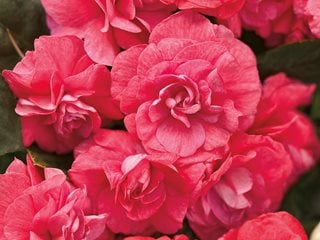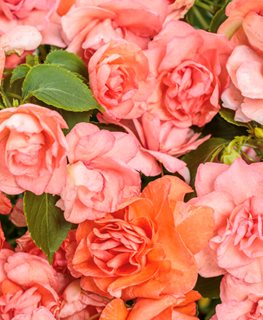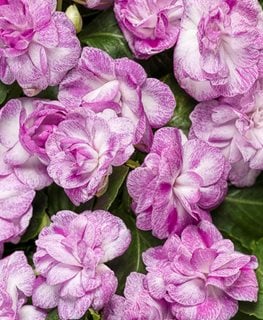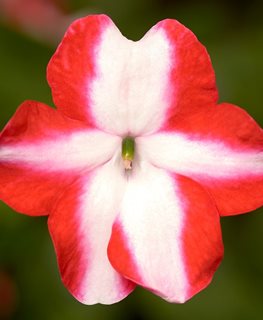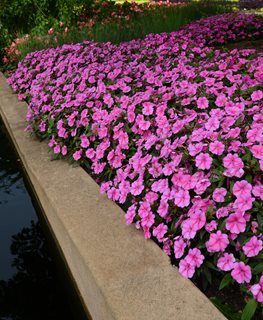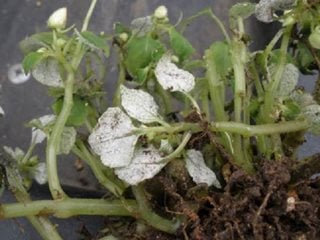Impatiens Flowers for Sun or Shade
It’s time to grow impatiens again! These tough, mildew-resistant cultivars will keep your garden in bloom all season long.For years, impatiens were my go-to annual for the shade garden because they bloom like mad and come in a variety of colors. And then one summer not so long ago, the blooming stopped—they had become victims of downy mildew.
Many nurseries were forced to stop carrying Impatiens walleriana to prevent the spread of the disease, and moved to the more resilient New Guinea impatiens. The good news is, these easy-to-grow shade annuals are back, thanks to new hybrids bred to fend off downy mildew. You’ll also find them in more flower and foliage colors than ever before.
On this page: Basics | Types | Growing Tips | Care | Impatiens Pictures | Garden Uses | What about Impatiens Downy Mildew?
- BASICS
- TYPES
- GROWING TIPS
- IMPATIENS CARE
- IMPATIENS PICTURES
- GARDEN USES
- WHAT ABOUT IMPATIENS DOWNY MILDEW?
BASICS
Botanical name:
Impatiens spp. (describing the “impatient" nature of the seed pods, which burst open when ripe to effectively disperse their contents).
Common names:
Impatiens, Touch-me-not plant, busy Lizzie, patient Lucy, sultana
Annual or perennial?
A tender herbaceous perennial in hardiness zones 10-11; grown as an annual in most regions of the country.
Bloom period:
Late spring until the first frost.
Mature height:
Anywhere from 8 to 12 inches tall for dwarf forms, to as tall as 3 feet for larger cultivars.
Sun or shade?
Impatiens walleriana varieties prefer light to medium shade; New Guinea impatiens will tolerate more sun.
TYPES
- Impatiens walleriana are the superstars of the shade garden and have been hybridized into a dizzying array of choices, including variegated forms, as well as single- and double-flowered varieties.
- New Guinea impatiens (I. hawkeri) are admired for their large, flamboyant flowers and often dark reddish or variegated foliage. They stand up well to wind and rain and are adaptable to most light conditions.
GROWING TIPS

Container combination featuring (top to bottom): Toucan® Scarlet canna lily, ColorBlaze® Wicked Hot™ coleus, Luscious® Goldengate™ lantana (left), and SunPatiens® Compact Orange impatiens (right). Photo by Proven Winners.
When to plant:
Set out transplants in early spring or sow seed indoors 8 to 10 weeks before your last frost date. They are very sensitive to cold temperatures, so be sure the threat of frost has passed and the soil has warmed up before planting impatiens in the ground.
Where to plant:
In fertile, well-draining soil enriched with organic matter. Plant I. walleriana in light to medium shade, keeping them out of direct sunlight. New Guinea impatiens will tolerate more sun if you keep their roots moist.
Plant spacing:
Closer spacing will encourage taller growth, while more distance between plants encourages them to spread out and fill in the gaps. Plant further apart if used as a ground cover.
Planting in containers:
Use a general-purpose, well-draining potting soil; one with a slow-release fertilizer will keep your plants well get them off to a good start. If combining impatiens with other annuals or perennials, choose varieties with the same exposure and watering requirements.
IMPATIENS CARE
Watering:
Impatiens are not drought tolerant, so they need to be watered regularly during dry spells to keep the soil consistently moist and prevent the plants from wilting. To help retain moisture, amend the soil with organic matter and apply a layer of mulch. If planted in pots, they may need to be watered daily during hot, dry weather.
Fertilizing:
Apply compost or a slow-release granular fertilizer at planting time. Container-grown plants may need more frequent feedings with a liquid fertilizer.
Pruning:
Although pruning is unnecessary, you can pinch plants back if they become tall and leggy to encourage bushier growth. Your plants will quickly respond with a new flush of blooms. Flowers are self-cleaning, sparing you the chore of deadheading.
Pest and diseases:
Few serious insect or pest problems bother impatiens, but your plants can still succumb to downy mildew if you are not growing a disease-resistant variety. See below for more information on downy mildew.
IMPATIENS PICTURES
Although the threat of downy mildew has abated over the last couple of years, it’s still best to seek out newer varieties of impatiens that are mildew-resistant, like those featured here:
GARDEN USES
With their quick growth habit and abundant bloom production, impatiens are great choices for your garden. Here are a few ways to use them:
- Use as bedding plants and container fillers, or wherever you want continuous color with minimal effort.
- Plant in window boxes or hanging baskets, at the front of a border, or as a groundcover under trees and shrubs.
- Varieties with flowers in softer pastel tones are wonderful accent plants in English or cottage gardens.
- Use sun-tolerant varieties with flowers in vibrant shades of salmon, coral, or orange to add a bright pop of color to a tropical garden.
- Double-flowered forms (such as the Proven Winners Rockapulco® series) are showy additions to container plantings or even for use as flowering houseplants.
- Check out this fun jellyfish hanging basket project that uses impatiens as well.
WHAT ABOUT DOWNY MILDEW?
What to look for:
The tell-tale signs of infection include yellowing leaves, wilting, and white spores on the undersides of the leaves.
How to prevent downy mildew:
The best preventive measures include keeping the leaves dry when watering and providing enough air circulation between plants. If you do find impatiens downy mildew, it’s almost impossible to get rid of, and it is best to remove and dispose of the affected plants.
To prevent reinfection, don’t plant new impatiens in the same garden bed. While the new plants may not have the disease (even types bred to be resistant are not completely immune), they could still fall victim if planted where spores still linger in the soil.
If you haven’t grown them for a few years or you plan to put them in containers, there is less to worry about. Or, plant New Guinea impatiens instead, which are naturally mildew-resistant. Read more about impatiens downy mildew and other alternatives to plant.
RELATED:
Made in the Shade—21 Great Shade Plants
Growing Annual Vinca

